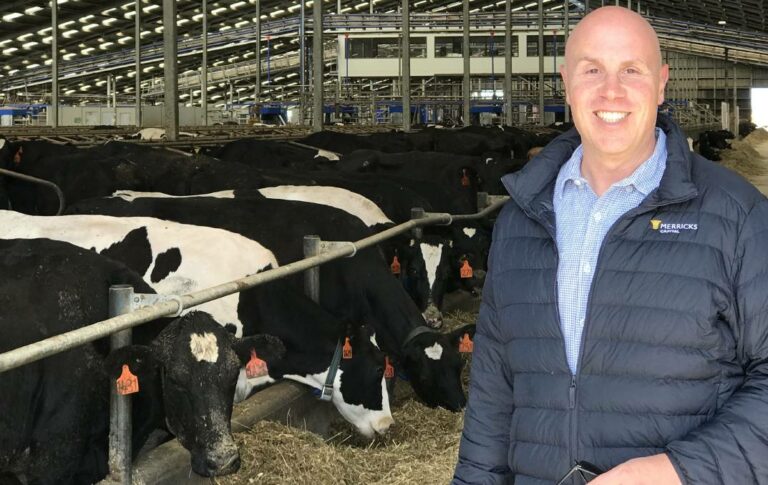By Andrew Marshall
Updated October 19 2023 – 1:01pm, first published 1:00pm
It’s a minnow among the really big fish in the agribusiness banking pool, but farmers and farm related businesses have proven well worth backing for one of the most active junior farm lenders many people would never have heard of.
In fact, Merricks Capital now boasts being Australia’s biggest non-bank rural lender.
It currently has a $1 billion loan portfolio supporting farm sector borrowings typically from $5 million to $30m, including some worth up to $100m.
At interest rates now around the 10 per cent mark, its loan book spans broadacre livestock and crop producers, dairy and horticultural farmers, and industry infrastructure operators such as ports and milk processors.
Initially in the farm commodity trading and rural property investment space when it began 17 years ago, Merricks has found a rewarding market niche providing alternatives to bank lending.
The Melbourne firm, backed by investors ranging from North American pension funds to local charities and private wealth investors, typically lends funds for periods of 12 months to four years.
Its loans often fund upgrades to farm operations at times when commodity markets or seasons are at a low point in their cycle.
“While a farm’s earnings outlook may be challenging at the time, it also could be the best period to add value to the business in readiness for a market turnaround in a year or two,” said Merricks executive chairman, Adrian Redlich.
Farm sector borrowers’ relying on conventional bank loans often found their investment plans thwarted because they could not generate the immediate and steady cash flows required to satisfy bankers’ loan guidelines and regulatory expectations.
“We’re providing a solution when capital might be scarce,” Mr Redlich said.
“Because immediate earnings and interest repayment capacity may be extremely challenged, it’s harder for agri bankers to take on a new loan.
“Ironically, commodity markets may be much improved in a couple of years and business returns much stronger, partly because the farm’s capacity has been enhanced by the value-adding investment.”
As a case in point, when farmgate milk prices in 2018 were almost half their current values and drought conditions were driving up feed and irrigation costs, Merricks Capital financed about $100m in loans to several southern Australian dairy farmers to invest in efficiency upgrades.
The lender calculated its finance would help improve irrigation capabilities and management efficiencies from various farm infrastructure upgrades, ensuring producers were much better positioned to cash in on future milk market rises.
It had rightly banked on milk shortages after the big run of herd culling and producer exits triggered by drought and the Murray Goulburn co-operative collapse savaging farmer payments.
By 2021 the milk market had indeed revived significantly, and was breaking records by 2022.
More recently Merricks funded a South Australian lamb and beef business’s sizeable property acquisition and sheep restocking agenda, taking advantage of this year’s 50pc fall in livestock values to buy sheep at discount prices.
Banks lending cools
While the past few years of big seasons, big commodity prices and cheap interest rates fuelled a surge of mainstream bank lending for farmland buying, infrastructure and machinery upgrades and restocking, Mr Redlich said current market corrections and patchy seasonal conditions had made bankers cautious about growing their lending exposure further.
“This was inevitable. They can’t keep lending at the pace they had been because they need to see plenty of cash flow to support their existing loans,” he said.
“By law they have to be conservative and highly prescriptive.
“Banks are restricted by increasingly tight regulations put in place to preserve the integrity of the banking system and the savings they hold for the Australian public.”
As an investment fund group, Merricks could focus more on customers’ potential asset valuation gains and longer term earnings, rather than prioritising current cash flow to service its loans.
In the past five years its agricultural credit fund has lent more than $1.3b in secured loans to producers in Australia and New Zealand.
Recent key investments included loans to buyers of mixed farming country in NSW’s Riverina and northern West Australia; refinancing debt facilities for an 8000 hectare NSW crop and dairy operation; recapitalising a big Tasmanian dairy farm; funds to buy a NZ orchard business, and a Queensland avocado grower buying a neighbouring South Burnett orchard, plus ongoing loan support to Victorian egg producer, Farm Pride Foods.
Investing rewards
Investors in Merricks agriculture-only fund have reaped about 10pc annualised returns since it began two years ago.
“Our investors tend to be people looking for solid, minimal risk investments which are a bit more interesting than money in the bank at current interest rates,” Mr Redlich said.
Agribusiness funding also makes up about 20pc of other Merricks Capital funds.
Aside from its farmer borrowers, the capital lender has teamed with others to fund South Australia’s T-Ports shallow harbour grain export facility at Lucky Bay.
T-Ports trans-ships grain via a smaller vessel from its 24,000 tonne storage site to cargo ships in deep water off the Eyre Peninsula.
Another port deal just inked in northern WA, saw Merricks financing just under half the cost of Broome’s $200m Kimberley Marine Support Base.
A 165 metre floating jetty will enable exports, including live cattle and Kimberley abattoir products, to be loaded day or night without the current logistical and time restrictions posed by the port’s big tide variations.
“We know this sort of investment can create real agriculture sector value for the region,” Mr Redlich said.
Merricks has also traded about $250m in farm commodities including grain harvest delivery contracts, since it was founded.
The investment firm’s origins in 2007 grew from its Australian principals, including Mr Redlich, previously working in Chicago and Asia in agricultural commodity markets and funds management jobs.
https://www.theland.com.au/story/8392489/banking-on-non-bank-ag-lending-makes-sense-for-merricks/



